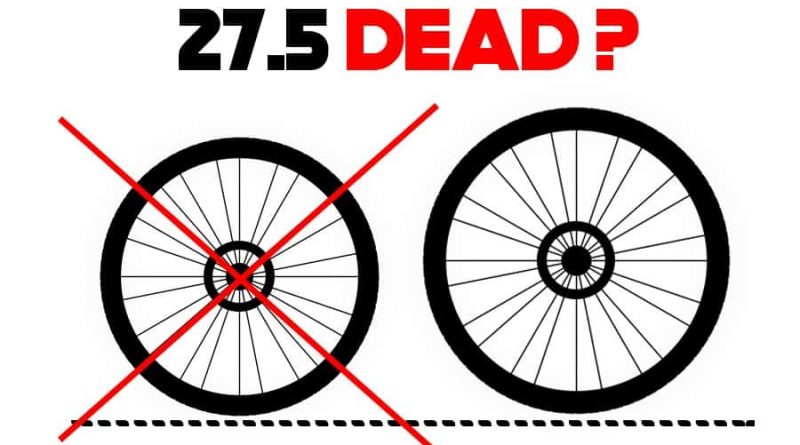Are 27.5 Inch Bikes Dead? (Answered)
27.5-inch bikes are absolutely not dead and could continue as a popular choice among many riders, however, 29-inch bikes certainly represent a threat to their market share.
It used to be that the majority of mountain bikes had twenty-six-inch wheels. This made life a lot simpler as it saved riders having to make a choice about what wheel size they wanted to go for – it was a one size fits all approach that made choosing a bike that little bit easier.
However, in the last few years, there has been a great deal of change in opinions regarding wheel size in mountain biking. Innovations have seen larger wheel sizes become increasingly common. And as the larger wheel sizes became more common, bike manufacturers have focused on ways to design their bikes specifically for the different wheel sizes.
- Are 27.5 Inch Wheels the Same as 650b?
- When did 27.5 Inch Wheels Become Popular?
- When Were the First Major Victories on 27.5-inch wheels?
- Are 27.5 Inch Wheels Better Than 26 Inch Wheels?
- Are 27.5 Inch Wheels Better Than 29 Inch Wheels?
- What Are 27.5 Inch Wheels Good For?
- What Wheel Size is Best for Me?
- Final Words
Are 27.5 Inch Wheels the Same as 650b?
Yes. Another term for 27.5-inch wheels is 650b. It is known as 650b because it is approximately 650mm in diameter from tyre edge to tyre edge. The letter B refers to the width of the tyre. This method of wheel sizing comes from the French known as nomenclature. Nomenclature is more commonly known from 700c road bike wheels. Also, It’s much less common but 27.5″ wheels are also known as 584 because the rim diameter is 584mm wide.
When did 27.5 Inch Wheels Become Popular?
27.5-inch bikes were initially pioneered by Kirk Pacenti in 2007. However, the uptake was initially slow. But by 2013 their growth in popularity was accelerating, with at least ten major bike brands offering bikes with 27.5-inch wheels.
When Were the First Major Victories on 27.5-inch wheels?
The first really noticeable results on 27.5-inch wheels were when Nino Schurter won a World Cup event in South Africa and placed second at the Olympics in 2012 on 27.5-inch wheels.
Are 27.5 Inch Wheels Better Than 26 Inch Wheels?
27.5-inch wheels are generally considered to be a better choice than 26-inch wheels. Their growth in popularity, to the point, that they have pushed the 26-inch wheel out as the industry standard. The reasons for this are as follows:
- Clearance. Larger wheels can roll over obstacles more easily.
- Speed. Due to the science of rotational inertia, they also hold their speed better than smaller wheels. This makes them more efficient so that they can keep going once they start rolling.
- Contact area. A larger wheel has a larger contact area between the rubber of the tire and the ground that it’s rolling on. This provides better traction and holds grip far better.
- Bike Geometry. It’s not just about the wheels themselves though. A knock-on effect is that the geometry of the bike itself is altered somewhat. Bikes with larger wheels are more stable because of the position of the cranks in relation to the axles as well as having a longer wheelbase.
Are 27.5 Inch Wheels Better Than 29 Inch Wheels?
27.5-inch wheels vs 29-inch wheels largely come down to personal preference. One complaint that has been levelled at 29-inch wheel bikes in the past is that they don’t handle well due to their extra size. The 27.5-inch wheel allows for more maneuverable bikes and a more playful ride. However, recent developments in bike geometry have allowed for bikes that are far more suited to the wheel size and the old complaints about maneuverability are not as valid as they once were. There are some things to consider though.
- Handling. One complaint that has been leveled at 29 inch wheel bikes in the past is that they don’t handle well due to their extra size. The 27.5-inch wheel allows for more maneuverable bikes and a more playful ride. However, recent developments in bike geometry has allowed for bikes that are far more suited to the wheel size and the old complaints about maneuverability are not as valid as they once were.
- Rider Size. Another issue with the geometry is that the larger bikes often aren’t suitable for smaller riders. While they don’t have such an issue with 27.5 inch bikes, the 29 inch ones can be a step too far and it can be harder to find ones that fit shorter riders.
- Weight Saving. The smaller wheels also help offer a weight saving on the larger bikes – this can be as much as two pounds total which can be an attractive proposition for riders who are more conscious of their bike weight.
What Are 27.5 Inch Wheels Good For?
27.5-inch wheels are good for most kinds of riding. They offer a good compromise between the old wheels size of 26 inches and the newer 29-inch wheels. They roll better than 26-inch wheels, yet are more manoeuvrable than 29-inch wheels, offering the best of both worlds or, at least, the best possible compromise.
Will 29 Inch Wheels Spell the End for 27.5 Inch Wheels?
29-inch wheels do not seem to be spelling the end for 27.5-inch wheels any time soon. 26-inch wheels fell away in popularity very quickly after the introduction of 27.5-inch wheels, but the same cannot be said for 27.5-inch wheels following the introduction of 29-inch wheels. But some of the old complaints about 29-inch wheels have now become largely redundant.
- Design focused on 29 inch bikes. Since about 2018 bike design with larger wheel sizes has advanced significantly and the 29-inch bikes are now a far more attractive proposition for new bike buyers.
- Maneuverability. One initial complaint that people had about the 29-inch bikes was that the lack of manoeuvrability was due to the gyroscopic effect of the larger wheels. However, research has now proven that the difference that this makes between the wheel sizes is actually very tiny. It has, in fact, been far more important for bike manufacturers to get used to the wheel size and find ways to make it work.
What Wheel Size is Best for Me?
The best wheel size for each rider still largely comes down to the individual rider’s preference. For shorter riders, there are still not quite as many options in the 29-inch market which may limit their choice somewhat.
When trying to choose which wheel size to go with, therefore, there is plenty of research and plenty of opinions available to read, and each bike manufacturer’s approach to the geometry of the bikes is different. But ultimately it’s best to demo as many bikes as you possibly can so that you can make your own decision based on what bike, and what wheel size, you feel best suits you.
Final Words
27.5 wheels are not dead because they fit smaller riders better than 29-inch wheel bikes. If you are looking to get the best of both worlds then a mullet bike might be a good option, this is where you have a 29inch front wheel and 27.5 (650b) inch rear wheel. At the end of the day, there is no right or wrong answer when it comes to wheel size, it’s just what you prefer.
You may also be interested in:




